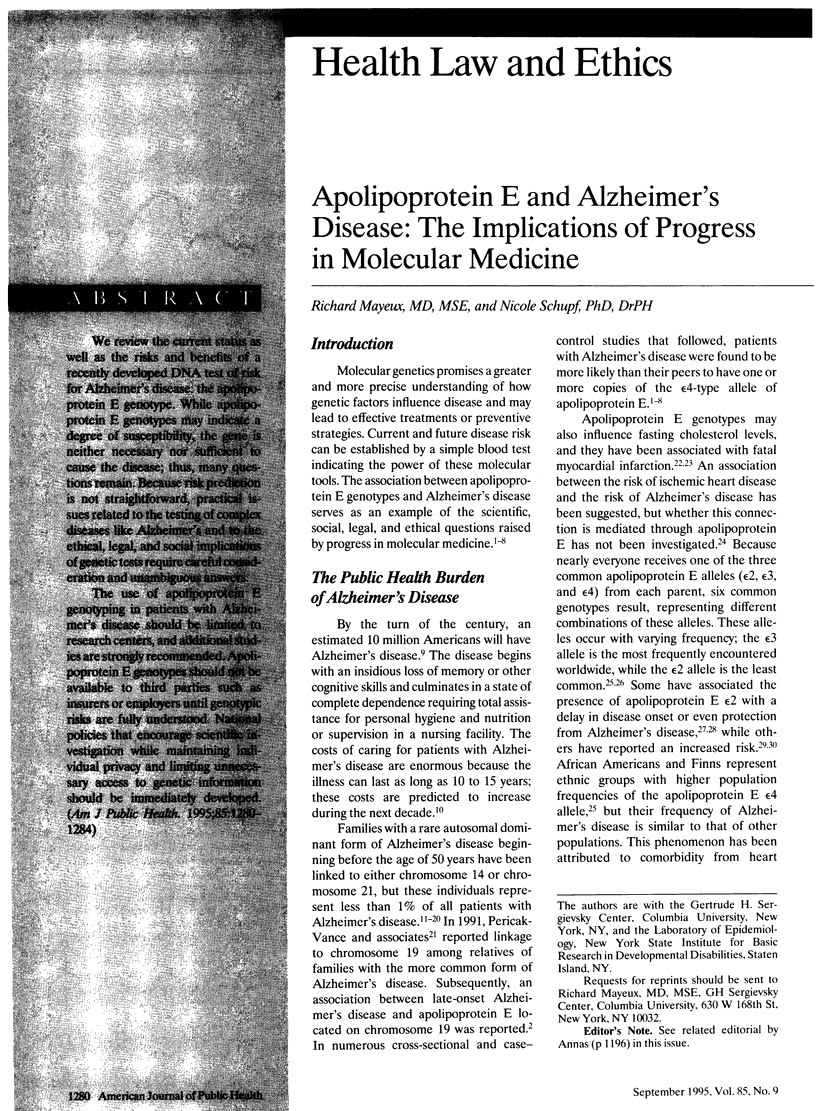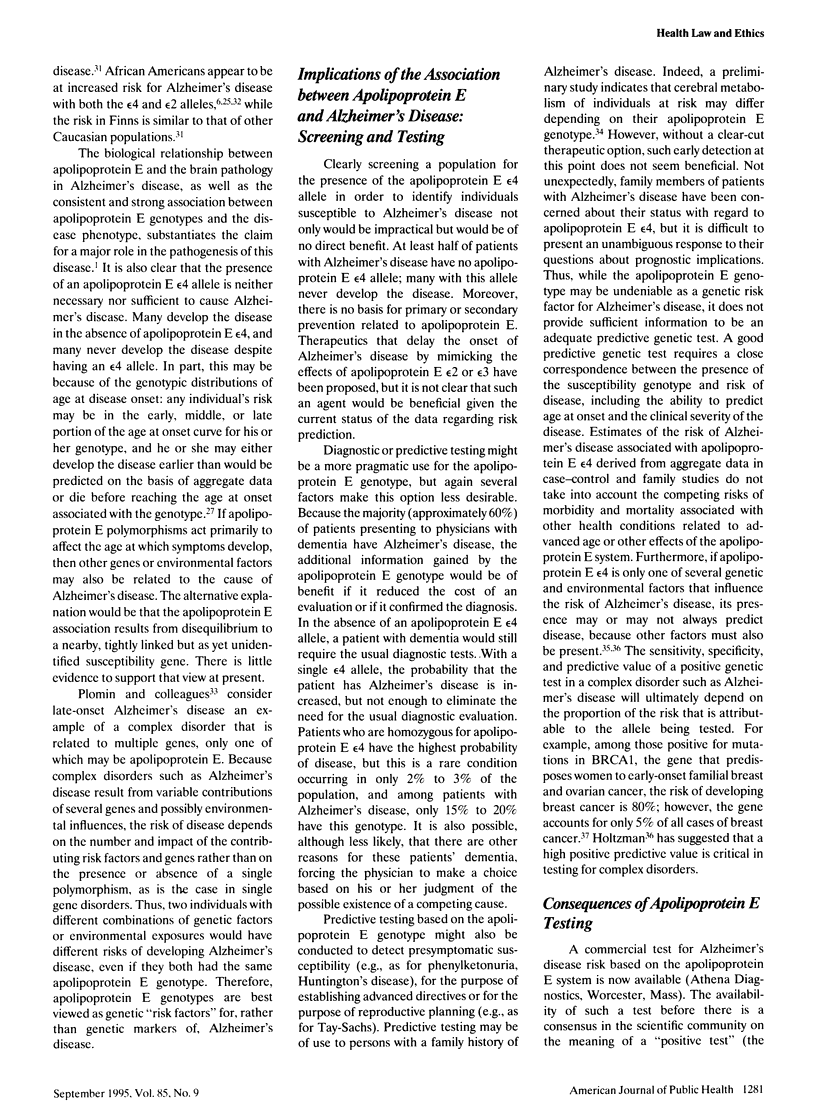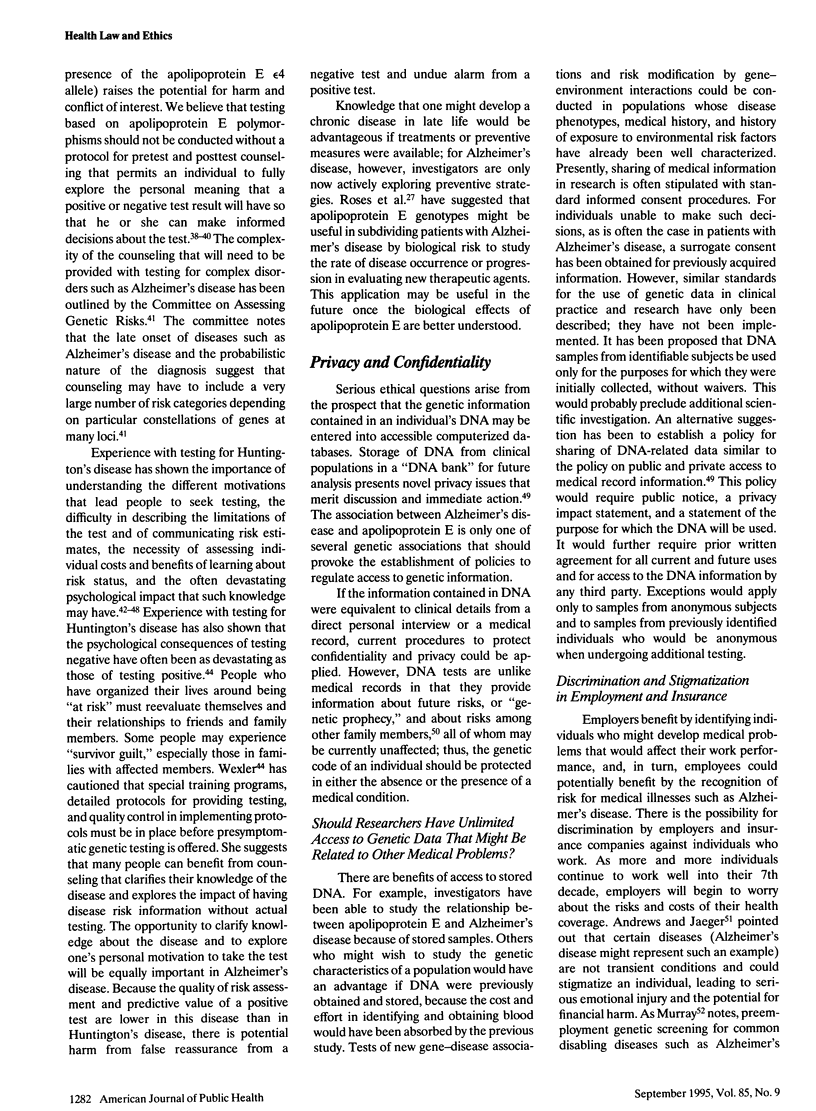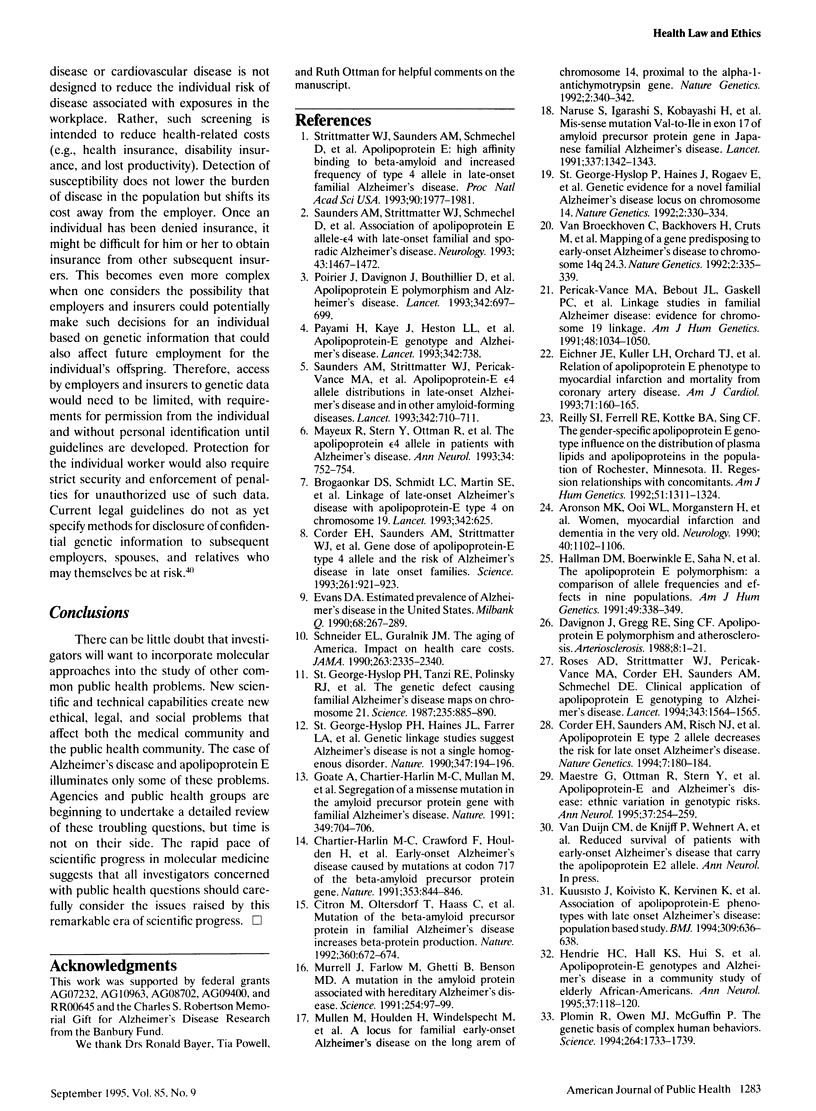Abstract
We review the current status as well as the risks and benefits of a recently developed DNA test of risk for Alzheimer's disease: the apolipoprotein E genotype. While apolipoprotein E genotypes may indicate a degree of susceptibility, the gene is neither necessary nor sufficient to cause the disease; thus, many questions remain. Because risk prediction is not straightforward, practical issues related to the testing of complex diseases like Alzheimer's and to the ethical, legal, and social implications of genetic tests require careful consideration and unambiguous answers. The use of apolipoprotein E genotyping in patients with Alzheimer's disease should be limited to research centers, and additional studies are strongly recommended. Apolipoprotein E genotypes should not be available to third parties such as insurers or employers until genotypic risks are fully understood. National policies that encourage scientific investigation while maintaining individual privacy and limiting unnecessary access to genetic information should be immediately developed.
Full text
PDF




Selected References
These references are in PubMed. This may not be the complete list of references from this article.
- Andrews L. B., Jaeger A. S. Confidentiality of genetic information in the workplace. Am J Law Med. 1991;17(1-2):75–108. [PubMed] [Google Scholar]
- Andrews L. B. Legal aspects of genetic information. Yale J Biol Med. 1991 Jan-Feb;64(1):29–40. [PMC free article] [PubMed] [Google Scholar]
- Annas G. J. Privacy rules for DNA databanks. Protecting coded 'future diaries'. JAMA. 1993 Nov 17;270(19):2346–2350. [PubMed] [Google Scholar]
- Aronson M. K., Ooi W. L., Morgenstern H., Hafner A., Masur D., Crystal H., Frishman W. H., Fisher D., Katzman R. Women, myocardial infarction, and dementia in the very old. Neurology. 1990 Jul;40(7):1102–1106. doi: 10.1212/wnl.40.7.1102. [DOI] [PubMed] [Google Scholar]
- Bloch M., Adam S., Wiggins S., Huggins M., Hayden M. R. Predictive testing for Huntington disease in Canada: the experience of those receiving an increased risk. Am J Med Genet. 1992 Feb 15;42(4):499–507. doi: 10.1002/ajmg.1320420416. [DOI] [PubMed] [Google Scholar]
- Borgaonkar D. S., Schmidt L. C., Martin S. E., Kanzer M. D., Edelsohn L., Growdon J., Farrer L. A. Linkage of late-onset Alzheimer's disease with apolipoprotein E type 4 on chromosome 19. Lancet. 1993 Sep 4;342(8871):625–625. doi: 10.1016/0140-6736(93)91458-x. [DOI] [PubMed] [Google Scholar]
- Brandt J., Quaid K. A., Folstein S. E., Garber P., Maestri N. E., Abbott M. H., Slavney P. R., Franz M. L., Kasch L., Kazazian H. H., Jr Presymptomatic diagnosis of delayed-onset disease with linked DNA markers. The experience in Huntington's disease. JAMA. 1989 Jun 2;261(21):3108–3114. [PubMed] [Google Scholar]
- Chartier-Harlin M. C., Crawford F., Houlden H., Warren A., Hughes D., Fidani L., Goate A., Rossor M., Roques P., Hardy J. Early-onset Alzheimer's disease caused by mutations at codon 717 of the beta-amyloid precursor protein gene. Nature. 1991 Oct 31;353(6347):844–846. doi: 10.1038/353844a0. [DOI] [PubMed] [Google Scholar]
- Citron M., Oltersdorf T., Haass C., McConlogue L., Hung A. Y., Seubert P., Vigo-Pelfrey C., Lieberburg I., Selkoe D. J. Mutation of the beta-amyloid precursor protein in familial Alzheimer's disease increases beta-protein production. Nature. 1992 Dec 17;360(6405):672–674. doi: 10.1038/360672a0. [DOI] [PubMed] [Google Scholar]
- Corder E. H., Saunders A. M., Risch N. J., Strittmatter W. J., Schmechel D. E., Gaskell P. C., Jr, Rimmler J. B., Locke P. A., Conneally P. M., Schmader K. E. Protective effect of apolipoprotein E type 2 allele for late onset Alzheimer disease. Nat Genet. 1994 Jun;7(2):180–184. doi: 10.1038/ng0694-180. [DOI] [PubMed] [Google Scholar]
- Corder E. H., Saunders A. M., Strittmatter W. J., Schmechel D. E., Gaskell P. C., Small G. W., Roses A. D., Haines J. L., Pericak-Vance M. A. Gene dose of apolipoprotein E type 4 allele and the risk of Alzheimer's disease in late onset families. Science. 1993 Aug 13;261(5123):921–923. doi: 10.1126/science.8346443. [DOI] [PubMed] [Google Scholar]
- Davignon J., Gregg R. E., Sing C. F. Apolipoprotein E polymorphism and atherosclerosis. Arteriosclerosis. 1988 Jan-Feb;8(1):1–21. doi: 10.1161/01.atv.8.1.1. [DOI] [PubMed] [Google Scholar]
- Eichner J. E., Kuller L. H., Orchard T. J., Grandits G. A., McCallum L. M., Ferrell R. E., Neaton J. D. Relation of apolipoprotein E phenotype to myocardial infarction and mortality from coronary artery disease. Am J Cardiol. 1993 Jan 15;71(2):160–165. doi: 10.1016/0002-9149(93)90732-r. [DOI] [PubMed] [Google Scholar]
- Elias S., Annas G. J. Generic consent for genetic screening. N Engl J Med. 1994 Jun 2;330(22):1611–1613. doi: 10.1056/NEJM199406023302213. [DOI] [PubMed] [Google Scholar]
- Evans D. A. Estimated prevalence of Alzheimer's disease in the United States. Milbank Q. 1990;68(2):267–289. [PubMed] [Google Scholar]
- Goate A., Chartier-Harlin M. C., Mullan M., Brown J., Crawford F., Fidani L., Giuffra L., Haynes A., Irving N., James L. Segregation of a missense mutation in the amyloid precursor protein gene with familial Alzheimer's disease. Nature. 1991 Feb 21;349(6311):704–706. doi: 10.1038/349704a0. [DOI] [PubMed] [Google Scholar]
- Hallman D. M., Boerwinkle E., Saha N., Sandholzer C., Menzel H. J., Csázár A., Utermann G. The apolipoprotein E polymorphism: a comparison of allele frequencies and effects in nine populations. Am J Hum Genet. 1991 Aug;49(2):338–349. [PMC free article] [PubMed] [Google Scholar]
- Hendrie H. C., Hall K. S., Hui S., Unverzagt F. W., Yu C. E., Lahiri D. K., Sahota A., Farlow M., Musick B., Class C. A. Apolipoprotein E genotypes and Alzheimer's disease in a community study of elderly African Americans. Ann Neurol. 1995 Jan;37(1):118–120. doi: 10.1002/ana.410370123. [DOI] [PubMed] [Google Scholar]
- Holtzman N. A. Benefits and risks of emerging genetic technologies: the need for regulation. Clin Chem. 1994 Aug;40(8):1652–1657. [PubMed] [Google Scholar]
- Huggins M., Bloch M., Wiggins S., Adam S., Suchowersky O., Trew M., Klimek M., Greenberg C. R., Eleff M., Thompson L. P. Predictive testing for Huntington disease in Canada: adverse effects and unexpected results in those receiving a decreased risk. Am J Med Genet. 1992 Feb 15;42(4):508–515. doi: 10.1002/ajmg.1320420417. [DOI] [PubMed] [Google Scholar]
- King M. C., Rowell S., Love S. M. Inherited breast and ovarian cancer. What are the risks? What are the choices? JAMA. 1993 Apr 21;269(15):1975–1980. [PubMed] [Google Scholar]
- Knoppers B. M., Chadwick R. The Human Genome Project: under an international ethical microscope. Science. 1994 Sep 30;265(5181):2035–2036. doi: 10.1126/science.8091225. [DOI] [PubMed] [Google Scholar]
- Kuusisto J., Koivisto K., Kervinen K., Mykkänen L., Helkala E. L., Vanhanen M., Hänninen T., Pyörälä K., Kesäniemi Y. A., Riekkinen P. Association of apolipoprotein E phenotypes with late onset Alzheimer's disease: population based study. BMJ. 1994 Sep 10;309(6955):636–638. doi: 10.1136/bmj.309.6955.636. [DOI] [PMC free article] [PubMed] [Google Scholar]
- Maestre G., Ottman R., Stern Y., Gurland B., Chun M., Tang M. X., Shelanski M., Tycko B., Mayeux R. Apolipoprotein E and Alzheimer's disease: ethnic variation in genotypic risks. Ann Neurol. 1995 Feb;37(2):254–259. doi: 10.1002/ana.410370217. [DOI] [PubMed] [Google Scholar]
- Mastromauro C., Myers R. H., Berkman B. Attitudes toward presymptomatic testing in Huntington disease. Am J Med Genet. 1987 Feb;26(2):271–282. doi: 10.1002/ajmg.1320260205. [DOI] [PubMed] [Google Scholar]
- Mayeux R., Stern Y., Ottman R., Tatemichi T. K., Tang M. X., Maestre G., Ngai C., Tycko B., Ginsberg H. The apolipoprotein epsilon 4 allele in patients with Alzheimer's disease. Ann Neurol. 1993 Nov;34(5):752–754. doi: 10.1002/ana.410340527. [DOI] [PubMed] [Google Scholar]
- Motulsky A. G. Predictive genetic diagnosis. Am J Hum Genet. 1994 Oct;55(4):603–605. [PMC free article] [PubMed] [Google Scholar]
- Mullan M., Houlden H., Windelspecht M., Fidani L., Lombardi C., Diaz P., Rossor M., Crook R., Hardy J., Duff K. A locus for familial early-onset Alzheimer's disease on the long arm of chromosome 14, proximal to the alpha 1-antichymotrypsin gene. Nat Genet. 1992 Dec;2(4):340–342. doi: 10.1038/ng1292-340. [DOI] [PubMed] [Google Scholar]
- Murray T. H. Ethical issues in human genome research. FASEB J. 1991 Jan;5(1):55–60. doi: 10.1096/fasebj.5.1.1825074. [DOI] [PubMed] [Google Scholar]
- Murrell J., Farlow M., Ghetti B., Benson M. D. A mutation in the amyloid precursor protein associated with hereditary Alzheimer's disease. Science. 1991 Oct 4;254(5028):97–99. doi: 10.1126/science.1925564. [DOI] [PubMed] [Google Scholar]
- Payami H., Kaye J., Heston L. L., Bird T. D., Schellenberg G. D. Apolipoprotein E genotype and Alzheimer's disease. Lancet. 1993 Sep 18;342(8873):738–738. [PubMed] [Google Scholar]
- Pericak-Vance M. A., Bebout J. L., Gaskell P. C., Jr, Yamaoka L. H., Hung W. Y., Alberts M. J., Walker A. P., Bartlett R. J., Haynes C. A., Welsh K. A. Linkage studies in familial Alzheimer disease: evidence for chromosome 19 linkage. Am J Hum Genet. 1991 Jun;48(6):1034–1050. [PMC free article] [PubMed] [Google Scholar]
- Plomin R., Owen M. J., McGuffin P. The genetic basis of complex human behaviors. Science. 1994 Jun 17;264(5166):1733–1739. doi: 10.1126/science.8209254. [DOI] [PubMed] [Google Scholar]
- Poirier J., Davignon J., Bouthillier D., Kogan S., Bertrand P., Gauthier S. Apolipoprotein E polymorphism and Alzheimer's disease. Lancet. 1993 Sep 18;342(8873):697–699. doi: 10.1016/0140-6736(93)91705-q. [DOI] [PubMed] [Google Scholar]
- Quaid Kimberly A., Morris Michael. Reluctance to undergo predictive testing: the case of Huntington disease. Am J Med Genet. 1993;45:41–45. [PubMed] [Google Scholar]
- Reilly S. L., Ferrell R. E., Kottke B. A., Sing C. F. The gender-specific apolipoprotein E genotype influence on the distribution of plasma lipids and apolipoproteins in the population of Rochester, Minnesota. II. Regression relationships with concomitants. Am J Hum Genet. 1992 Dec;51(6):1311–1324. [PMC free article] [PubMed] [Google Scholar]
- Roses A. D., Strittmatter W. J., Pericak-Vance M. A., Corder E. H., Saunders A. M., Schmechel D. E. Clinical application of apolipoprotein E genotyping to Alzheimer's disease. Lancet. 1994 Jun 18;343(8912):1564–1565. doi: 10.1016/s0140-6736(94)92960-2. [DOI] [PubMed] [Google Scholar]
- Saunders A. M., Strittmatter W. J., Schmechel D., George-Hyslop P. H., Pericak-Vance M. A., Joo S. H., Rosi B. L., Gusella J. F., Crapper-MacLachlan D. R., Alberts M. J. Association of apolipoprotein E allele epsilon 4 with late-onset familial and sporadic Alzheimer's disease. Neurology. 1993 Aug;43(8):1467–1472. doi: 10.1212/wnl.43.8.1467. [DOI] [PubMed] [Google Scholar]
- Schneider E. L., Guralnik J. M. The aging of America. Impact on health care costs. JAMA. 1990 May 2;263(17):2335–2340. [PubMed] [Google Scholar]
- Small G. W., Mazziotta J. C., Collins M. T., Baxter L. R., Phelps M. E., Mandelkern M. A., Kaplan A., La Rue A., Adamson C. F., Chang L. Apolipoprotein E type 4 allele and cerebral glucose metabolism in relatives at risk for familial Alzheimer disease. JAMA. 1995 Mar 22;273(12):942–947. [PubMed] [Google Scholar]
- St George-Hyslop P. H., Haines J. L., Farrer L. A., Polinsky R., Van Broeckhoven C., Goate A., McLachlan D. R., Orr H., Bruni A. C., Sorbi S. Genetic linkage studies suggest that Alzheimer's disease is not a single homogeneous disorder. Nature. 1990 Sep 13;347(6289):194–197. doi: 10.1038/347194a0. [DOI] [PubMed] [Google Scholar]
- St George-Hyslop P. H., Tanzi R. E., Polinsky R. J., Haines J. L., Nee L., Watkins P. C., Myers R. H., Feldman R. G., Pollen D., Drachman D. The genetic defect causing familial Alzheimer's disease maps on chromosome 21. Science. 1987 Feb 20;235(4791):885–890. doi: 10.1126/science.2880399. [DOI] [PubMed] [Google Scholar]
- St George-Hyslop P., Haines J., Rogaev E., Mortilla M., Vaula G., Pericak-Vance M., Foncin J. F., Montesi M., Bruni A., Sorbi S. Genetic evidence for a novel familial Alzheimer's disease locus on chromosome 14. Nat Genet. 1992 Dec;2(4):330–334. doi: 10.1038/ng1292-330. [DOI] [PubMed] [Google Scholar]
- Strittmatter W. J., Saunders A. M., Schmechel D., Pericak-Vance M., Enghild J., Salvesen G. S., Roses A. D. Apolipoprotein E: high-avidity binding to beta-amyloid and increased frequency of type 4 allele in late-onset familial Alzheimer disease. Proc Natl Acad Sci U S A. 1993 Mar 1;90(5):1977–1981. doi: 10.1073/pnas.90.5.1977. [DOI] [PMC free article] [PubMed] [Google Scholar]
- Van Broeckhoven C., Backhovens H., Cruts M., De Winter G., Bruyland M., Cras P., Martin J. J. Mapping of a gene predisposing to early-onset Alzheimer's disease to chromosome 14q24.3. Nat Genet. 1992 Dec;2(4):335–339. doi: 10.1038/ng1292-335. [DOI] [PubMed] [Google Scholar]
- Wexler N. S., Rose E. A., Housman D. E. Molecular approaches to hereditary diseases of the nervous system: Huntington's disease as a paradigm. Annu Rev Neurosci. 1991;14:503–529. doi: 10.1146/annurev.ne.14.030191.002443. [DOI] [PubMed] [Google Scholar]
- Wexler N. S. The Tiresias complex: Huntington's disease as a paradigm of testing for late-onset disorders. FASEB J. 1992 Jul;6(10):2820–2825. doi: 10.1096/fasebj.6.10.1386047. [DOI] [PubMed] [Google Scholar]
- Wiggins S., Whyte P., Huggins M., Adam S., Theilmann J., Bloch M., Sheps S. B., Schechter M. T., Hayden M. R. The psychological consequences of predictive testing for Huntington's disease. Canadian Collaborative Study of Predictive Testing. N Engl J Med. 1992 Nov 12;327(20):1401–1405. doi: 10.1056/NEJM199211123272001. [DOI] [PubMed] [Google Scholar]


